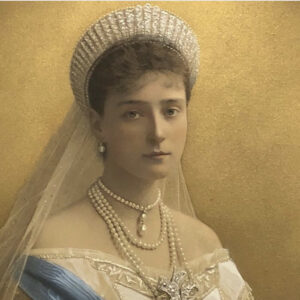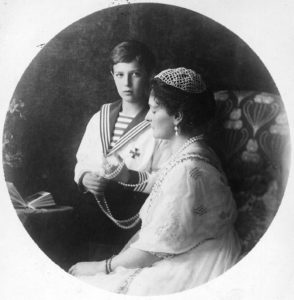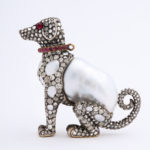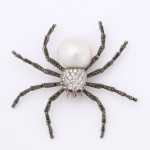An article about the use of glass in jewelry is now on Wallpaper.com, featuring pieces from ALVR’s collection.
ALVR in Wallpaper Magazine
The Adventurine Interviews ALVR’s Peter Schaffer
“While I know it is easy to get swept up in the negativity and fear, I also know that this too shall pass. I come from a longline of optimists who have lived through some of the most difficult times in history,” says ALVR’s Peter Schaffer, recently interviewed about our history, present, and future. Read more on The Adventurine.
ALVR Blog: The Empress of Gems – Pearls
Appropriately dubbed “the queen of gems,” pearls have long been associated with royalty, crowning the heads of many queens throughout history. Cleopatra’s legendary pearl earrings, Byzantium’s Empress Theodora’s pearl tiara, and Queen Elizabeth’s pearl-studded ensembles, for example, immediately spring to mind. But here at A La Vieille Russie, we think of Empress Alexandra Feodorovna.
 The Tsarina was not particularly interested in fashion, preferring simpler, lightweight gowns to the sumptuous finery she donned at court. Her taste in jewelry was similar, favoring pearls over other gems, noted by American writer Kellogg Durland, who traveled to Russia in 1907 to write about the Empress. He later reflected on this visit in his 1911 book, “Royal Romances of To-Day” in which he remarks on Alexandra’s fondness for pearls:
The Tsarina was not particularly interested in fashion, preferring simpler, lightweight gowns to the sumptuous finery she donned at court. Her taste in jewelry was similar, favoring pearls over other gems, noted by American writer Kellogg Durland, who traveled to Russia in 1907 to write about the Empress. He later reflected on this visit in his 1911 book, “Royal Romances of To-Day” in which he remarks on Alexandra’s fondness for pearls:
The Tsaritsa’s pearls, which she wears with her court costume are famous the world over. […] Perhaps, of all her jewels, she cares most for a long string of wonderful pearls, which she wears very often. The string is so long that she can wear it twice around her neck, and yet have the longest loop reach to her knees. The short loop comes to the waistline, and is finished with one single pear-shaped pearl of enormous value.
This penchant for pearls was nicely documented, for example, in our colored photograph of the Empress (pictured above) and in this charming photograph of Alexandra and the Tsarevich, Alexei, playing with her pearls:

Empress Alexandra and the Tsarevich, Alexei, via Wikimedia Commons
Who can blame the Empress’s preference for pearls? These gems of the sea have captivated mankind for millennia and it’s easy to see why, from their beautiful luster to their seemingly magical, organic formation.
Pearls have long been associated with purity, innocence, and humility, qualities that can be attributed to their mystifying, organic origins. American mineralogist, (and Tiffany & Co. Vice President 1879-1932), George Fredirick Kunz explains how:
“Unlike other gems, the pearl comes to us perfect and beautiful, direct from the hand of nature. Other precious stones receive careful treatment from the lapidary, and owe much to his art. The pearl, however, owes nothing to man […] it is absolutely a gift of nature, on which man cannot improve.”
As an organic gem, the pearl’s origins intrigued and perplexed man for centuries. Its association with the sea led to many water-inspired myths and theories. Ancient poets surmised that pearls formed from tears of the gods that fell into open oysters. Similarly, in Greek and Roman mythology, Aphrodite/Venus shook droplets of water from herself as she rose from the sea, the droplets then hardening into pearls. Such myths inspired the belief that pearls formed from drops of dew, a theory that persisted for centuries. This theory endured until around the 16th century, when naturalists began to speculate that pearls formed from oyster eggs.
Pearls in fact are the result of a mollusks response to a foreign particle. The pearls form when layers of nacre (mother of pearl), a variety of calcium carbonate, surround a foreign particle, like a grain of sand or a parasite.
For centuries, the main sources of pearls were the warm waters of the Persian Gulf, the Red Sea, and the Indian Ocean, as well as the rivers and lakes of China and the coast of Japan. After 1492, the discovery of pearls in the New World provided Europe a supply so great that the region came to be called the “Land of Pearls.
 Pearls come in many colors, ranging from white to black, and varying shades of cream, gray, blue, yellow, lavender, green, and mauve. The color produced depends on the mollusk and its environment. Pearls also vary in size, from tiny seed pearls, to large, irregularly shaped baubles called baroque pearls. Baroque pearls were popular in their namesake Baroque period but also so during the Renaissance, when jewelers fashioned them into pendants and brooches resembling animals, mermaids, and other creative, figural representations. Baroque pearls continued to inspire jewelers in subsequent periods, including during the Renaissance Revival period in the mid-nineteenth century, and even later.
Pearls come in many colors, ranging from white to black, and varying shades of cream, gray, blue, yellow, lavender, green, and mauve. The color produced depends on the mollusk and its environment. Pearls also vary in size, from tiny seed pearls, to large, irregularly shaped baubles called baroque pearls. Baroque pearls were popular in their namesake Baroque period but also so during the Renaissance, when jewelers fashioned them into pendants and brooches resembling animals, mermaids, and other creative, figural representations. Baroque pearls continued to inspire jewelers in subsequent periods, including during the Renaissance Revival period in the mid-nineteenth century, and even later.
 Contemporary jewelers continue to use pearls in creative ways. For example, a large cultured pearl is used as the body in this late 20th century spider brooch. A cultured pearl results from manmade intervention in the pearl-making process. A particle, such as a bead or a piece of shell, is placed inside a mollusk for the layers of nacre to form around it. While such attempts existed for centuries, it wasn’t until the turn of the twentieth century when a number of individuals successfully refined the process. What was once a rare jewel only accessible to royals and aristocrats now became attainable for many people throughout the world.
Contemporary jewelers continue to use pearls in creative ways. For example, a large cultured pearl is used as the body in this late 20th century spider brooch. A cultured pearl results from manmade intervention in the pearl-making process. A particle, such as a bead or a piece of shell, is placed inside a mollusk for the layers of nacre to form around it. While such attempts existed for centuries, it wasn’t until the turn of the twentieth century when a number of individuals successfully refined the process. What was once a rare jewel only accessible to royals and aristocrats now became attainable for many people throughout the world.
Throughout history, pearls were not just prized for adornment, but also valued for their presumed curative properties. Ingesting pearls was believed to cure any number of ailments, from indigestion to melancholia. Elixirs were made with pulverized pearl and vinegar, sometimes with the addition of lemon juice and other ingredients. While we can’t speak on the curative benefits of ingesting pearls (in fact, please don’t), wearing them is sure to chase away the blues! As George Fredirick Kunz, said, “there are few ills to which women are subject that cannot be bettered or at least endured with greater patience when the sufferer receives a gift of pearls.” At ALVR we’re pleased to offer a lovely assortment of pearl gifts, from brooches to rings.


745 Fifth Avenue, 4th Floor, NYC 10151
1.212.752.1727
Terms of Sale | Terms of Use | Privacy Policy
© A La Vieille Russie | Site by 22.